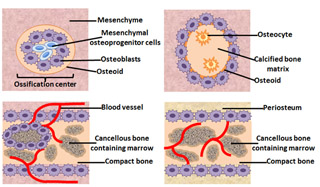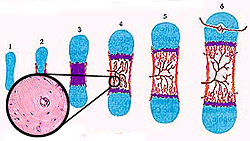|
Intramembranous and Endochondral
Ossification There are two
types of bone development: intramembranous and endochondral
ossification or osteogenesis. Regardless of the ossification
process, the histological structure of the bone is the same.
-
 Intramembranous
ossification gives rise to membrane bones, these being the
flat bones of the skull and parts of the mandible. This process
involves the deposition of bone matrix (osteoid) directly in
regions ("membranes") of embryonic mesenchyme.
Click here, or
look at the image to the right, for a full-size, printable
version of the picture detailing this process. Intramembranous
ossification gives rise to membrane bones, these being the
flat bones of the skull and parts of the mandible. This process
involves the deposition of bone matrix (osteoid) directly in
regions ("membranes") of embryonic mesenchyme.
Click here, or
look at the image to the right, for a full-size, printable
version of the picture detailing this process.
-
 Bones
of the extremities, pelvis, and vertebral column
(cartilage bones) are formed by endochondral ossification.
This process involves the replacement of a hyaline cartilage
model with bone beginning during fetal development and
ending in late adolescence. Bones
of the extremities, pelvis, and vertebral column
(cartilage bones) are formed by endochondral ossification.
This process involves the replacement of a hyaline cartilage
model with bone beginning during fetal development and
ending in late adolescence.
- Let's look at
some examples.
|